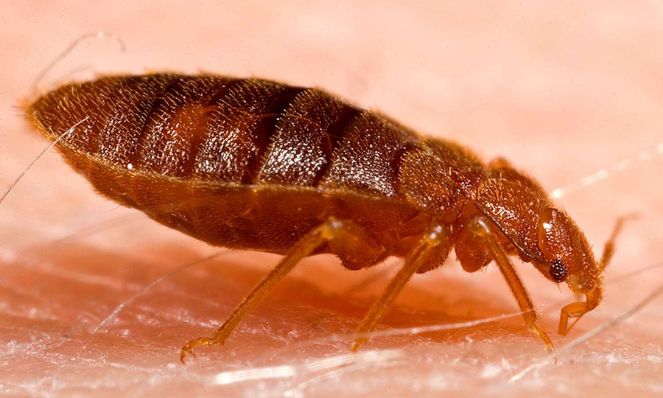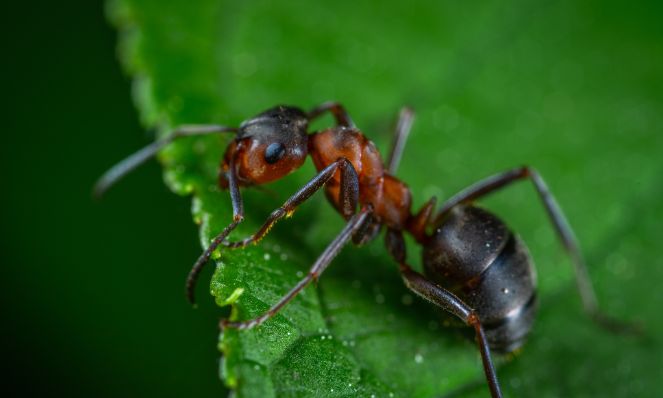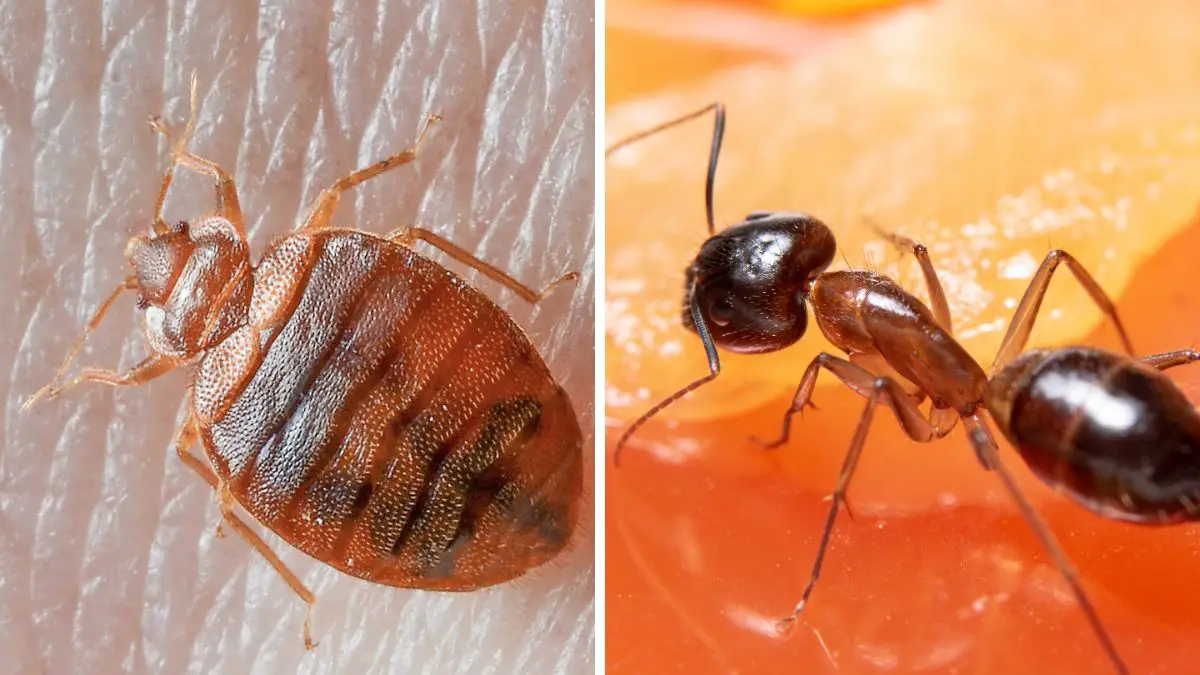The incessant buzzing, the itchy bites, and the general feeling of invasion can turn your sanctuary into a nightmare. Bed bugs and ants are two common culprits that can wreak havoc in your home.
In this blog post, we’ll dive deep into the differences between these two tiny nuisances, helping you understand their behaviors, identify them, and ultimately, control their population.
So, let’s explore bed bugs vs. ants to ensure you’re prepared for any possible infestation!
What are Bed Bugs?

Identifying bed bugs and ants is the first step in combating their infestations. Bed bugs are reddish-brown, flat, oval-shaped insects measuring about 4-5 mm long.
They are notorious for their nocturnal nature and their preference for hiding in crevices near their human hosts.
What are Ants?

Conversely, ants vary in size, shape, and color depending on the species.
Common ants include black ants, which measure about 3-4 mm in length, and carpenter ants, which tend to be larger and have reddish or black bodies.
Ants are usually active during the day and tend to build nests near food sources.
Bed Bug Behavior & Ant Behavior
Understanding the behavioral patterns of bed bugs and ants is crucial in devising effective strategies to control their populations.
Bed bugs are nature’s little hitchikers…they can easily travel from place to place by attaching themselves to clothes, luggage, or furniture.
Once they find a suitable host, they feed on human blood, usually during the night, leaving behind itchy and swollen bite marks.
On the other hand, ants are primarily motivated by their search for food and water.
They follow chemical trails, often formed by scout ants, to lead their colony to a potential food source.
While ants don’t pose a direct health threat through biting or spreading disease, they can contaminate food and cause structural damage by excavating nests in wooden structures.
Bed Bug vs. Ant Infestation
Bed bugs and ants tend to infest different areas of your home due to their varied preferences.
Bed bugs prefer to hide in cracks and crevices close to where you sleep, such as mattress seams, headboards, and baseboards.
They can even seek refuge in electrical outlets or behind wallpaper.
When an infestation occurs, bed bugs will typically leave behind blood spots, shed skins, and tiny black fecal spots.
Conversely, ants are generally attracted to sugar, protein, or moisture sources.
You may find them in kitchens, pantries, or bathrooms near food storage areas or water sources.
Look for trails of ants, piles of discarded wings near windows, or signs of structural damage in wooden structures.
Infestation Control Methods
Now that we’ve identified the key differences between bed bugs and ants, let’s discuss various control methods to tackle these pests.
Infestation Control Tips for Ants
- Seal Entry Points: Ants can find their way into your home through tiny cracks and gaps. Inspect your doors, windows, and foundation for any potential entry points and seal them using caulk or weatherstripping.
- Keep Food Sealed: Ants are attracted to food sources, so make sure to keep your food containers tightly sealed. Avoid leaving crumbs or spills unattended and clean up any food residue promptly.
- Wipe Down Surfaces: Regularly wipe down countertops, tables, and other surfaces to eliminate any food or sweet residue that may attract ants.
- Remove Attractants: Ants are particularly drawn to sweet substances. Keep sugary foods, pet food, and honey jars off the countertops and store them securely.
- Trim Vegetation: Ants often use vegetation as bridges to enter homes. Trim back any tree branches or shrubs that touch the exterior of your house to reduce this access point.
- Use Ant Bait: Consider strategically placing ant bait traps along their trails if you notice ant activity. The foraging ants will carry the bait back to the colony, helping control the infestation at its source.
- Use Natural Repellents: Some natural repellents, like cinnamon, vinegar, or citrus oils, can deter ants from entering your home. Spray these substances along ant entry points or use them in cleaning solutions.
Infestation Control Tips for Bed Bugs
- Thoroughly Inspect Second-Hand Items: When bringing used furniture or clothing into your home, inspect them carefully for any signs of bed bugs. Washing and drying clothing at high temperatures can help eliminate any potential hitchhikers.
- Use Mattress Encasements: Cover your mattress and box spring with bed bug-proof encasements. These covers prevent bed bugs from infesting these areas and make it easier to spot and eliminate them.
- Declutter Your Home: Bed bugs can hide in clutter, which makes finding and treating them difficult. Reduce the clutter in your living space to minimize potential hiding spots.
- Vacuum Regularly: Vacuuming your floors, carpets, and upholstery can help remove bed bugs and their eggs. Be sure to dispose of the vacuum bag in a sealed plastic bag outside your home.
- Steam Cleaning: Steam clean your mattress, furniture, and carpeting to kill bed bugs and their eggs. The high temperatures effectively eliminate these pests.
- Use Insecticides: Insecticides specifically labeled for bed bugs can be used to treat infested areas. Follow the instructions carefully, and consider consulting a professional for severe infestations.
- Professional Extermination: If your bed bug infestation persists, consider hiring a professional exterminator experienced in bed bug control. They have the expertise and tools to eradicate these resilient pests effectively.
By following these infestation control tips for both ants and bed bugs, you can better protect your home and minimize the impact of these unwanted visitors.
If you face a severe infestation, seeking professional assistance is always wise.
Ants vs. Bedbugs: Professional Help
Speaking of hiring a professional exterminator…while DIY methods can be effective for small infestations, larger or persistent ones may require professional intervention.
Pest control professionals have the knowledge, experience, and specialized equipment to tackle bed bugs or ant infestations in a targeted and effective way.
Professional Home Treatment for Ants
When dealing with a persistent ant infestation, seeking the expertise of a professional pest control service can be highly beneficial.
Here is an overview of the process of professional home treatment for ants:
- Inspection: The first step in the process is a thorough inspection of your home by the pest control technician. They will identify the ant species present, locate their nests, and determine the extent of the infestation.
- Customized Treatment Plan: Based on the inspection findings, the pest control expert will develop a customized treatment plan tailored to your specific ant infestation. Different ant species may require different approaches for effective control.
- Targeted Application: Professional pest control services use specialized insecticides and baits designed to target ants while minimizing harm to humans and pets. These products are often unavailable to consumers and require proper handling and application.
- Nest Elimination: Treating the ant nest directly is crucial for long-term control. Pest control technicians are trained to locate and eliminate ant nests, disrupting the colony and preventing further infestations.
- Exterior Barrier Treatment: To prevent future ant invasions, the pest control team may apply a perimeter barrier treatment around the exterior of your home. This acts as a protective shield to keep ants from entering.
- Follow-Up Inspections: Depending on the severity of the infestation, follow-up inspections may be scheduled to ensure the treatment’s effectiveness. Additional treatments may be applied if necessary.
- Prevention Tips: A reputable pest control service will provide you with tips on how to prevent future ant infestations. They may advise you on proper sanitation, sealing entry points, and eliminating ant attractants.
Professional Home Treatment for Bed Bugs
Bed bug infestations are notoriously challenging to eradicate, often requiring professional intervention.
Here’s what the process of professional home treatment looks like for bed bugs:
- Inspection: A skilled pest control technician will conduct a detailed inspection of your home to confirm the presence of bed bugs. They will identify the areas of infestation, including bedrooms, furniture, and other hiding spots.
- Treatment Preparation: Before the treatment begins, you will need to prepare your home by removing clutter, laundering bedding and clothing, and vacuuming thoroughly. This preparation ensures the treatment’s effectiveness.
- Heat Treatment or Insecticides: Professional bed bug treatment may involve heat treatment, which raises the temperature in infested areas to a level lethal to bed bugs and their eggs. Alternatively, insecticides specifically designed for bed bug control may be used.
- Steam Treatment: Steam cleaning effectively treats mattresses, upholstery, and other furniture where bed bugs may be hiding. The high temperatures kill bed bugs and their eggs on contact.
- Mattress Encasements: To prevent future infestations and protect your bedding, the pest control technician may recommend using bed bug-proof mattress encasements.
- Follow-Up Treatments: Bed bug infestations often require multiple treatments to ensure complete eradication. Follow-up treatments are typically scheduled to target any surviving bed bugs and newly hatched nymphs.
- Preventive Measures: After the treatment is complete, the pest control expert may offer advice on preventing future bed bug infestations, such as regular inspections, early detection, and maintaining a clutter-free environment.
Professional home treatment for ants and bed bugs is a comprehensive and effective approach to eliminating these pests and ensuring your home remains pest-free.
Hiring a reputable pest control service gives you access to expert knowledge, specialized tools, and treatments that are not available to the general public, making it a worthwhile investment in maintaining a pest-free home environment.
Wrapping it Up
Bed bugs and ants can create headaches in your home, but understanding their differences is key to successfully tackling these pests.
You can regain control of your living space by knowing how to identify them, understanding their behavior, and implementing appropriate control methods.
Remember, prevention is always better than cure regarding pest management. So, take proactive measures to protect your home against these tiny intruders!


